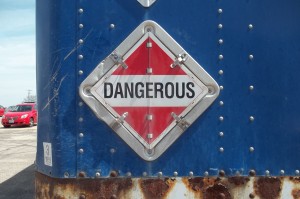A common question for anyone who transports hazardous materials by highway is some variation of, “When, and how, do I use the Dangerous placard”? I received another of these questions from someone in the transportation industry on June 27, 2016:
If I have over 1,001 lbs but less than 2,205 lbs of a hazard class plus under 1,001 of another hazard class can I use a dangerous placard? All hazard classes are in table 2.
I had a response ready for him (6.27.16):
Thank you for contacting me with your question. I believe I have an answer for you.
- When a vehicle contains 1,001 pound of more of hazardous materials in non-bulk packages, it must display the applicable placard for each hazardous material [49 CFR 172.504(a)]. Unless an exception exists.
- A vehicle that contains 2 or more hazardous materials in non-bulk packages that require placards may substitute the Dangerous placard for the placards representing each hazard [49 CFR 172.504(b)].
- The Dangerous placard option is not available for certain HazMat identified in Table 2 at 49 CFR 172.504(e) [49 CFR 172.504(b)].
- However, when 1,000 kg (2,205 lbs) or more of one category of material is loaded at one facility, the placard for that HazMat must be displayed on the vehicle [49 CFR 172.504(b)]. Read: When not to use the Dangerous Placard.
I hope this helps.
Please don’t hesitate to contact me with any other questions.
He wanted a little clarification so he re-phrased the question:
To better phrase my question, if I had say 1,400 lbs of class 8 Corrosive and 300 lbs of 2.2 Non-Flammable Gas could I use a Dangerous placard to cover both or could I just use a Corrosive placard to cover the class 8 only due to the class 2.2 being less than 1,001 lbs? What if the class 8 was 800 lbs and the class 2.2 was 350 lbs for a total of 1,150 lbs? How would I need to placard that, if at all?
Thanks,
My reply:
I will answer your questions separately:
- Scenario 1: 1,400 lbs of class 8 Corrosive and 300 lbs of 2.2 Non-Flammable Gas. In this scenario the aggregate weight of HazMat in Table 2 of 49 CFR 173.504(e) on the vehicle is ≥1,001 lbs which, per 49 CFR 173.504(a) and (c) requires the vehicle to display placards for both Class 8 and Class 2.2. USDOT regulations at 49 CFR 173.504(b) allow for the option to display the Dangerous placard in situations where two or more HazMat on a vehicle are required to display placards. That is the situation here. Therefore:
- Option 1 – Vehicle displays Class 8 Corrosive and Class 2.2 Non-Flammable Gas placards.
- Option 2 – Vehicle displays Dangerous placard only.
- Scenario 2: Class 8 was 800 lbs and the class 2.2 was 350 lbs for a total of 1,150 lbs. See Scenario 1.
- Scenario 3 (mine): Class 8 Corrosive 500 lbs. Class 2.2 Non-Flammable Gas 300 lbs. In this scenario the aggregate gross weight of the HazMat in Table 2 of 49 CFR 173.504(e) on the vehicle is <1,001 lbs. Therefore, per 49 CFR 173.504(c) placards are not required to be displayed on the vehicle. USDOT regulations at 49 CFR 173.502(c) allow for the display of placards when not required if the HazMat is present. However, the Dangerous placard may only be displayed if required. Therefore:
- Option 1 – Vehicle displays no placards.
- Option 2 – Vehicle displays Class 8 Corrosive and Class 2.2 Non-Flammable Gas placards.
I think that satisfied him.
The use of the Dangerous placard is a source of confusion for many in the transportation industry. It’s certainly not the first question I’ve received.
- Q&A: Using the Dangerous Placard in Place of Multiple HazMat Placards
- Q&A: Use of the Dangerous Placard on a Motor Vehicle in Transportation
- Q&A: Displaying the Dangerous Placard on a Motor Vehicle
Contact me with any questions you may have about the transportation of hazardous materials by air, highway, vessel, or rail International and Domestic Daniels Training Services 815.821.1550 |
